VO2-Based Spacecraft Smart Radiator with High Emissivity Tunability and Protective Layer
Abstract
:1. Introduction
2. Principle and Simulation
2.1. Structure Design
2.2. Optical Simulation
2.3. Calculation of the Optical Properties
3. Results and Discussion
3.1. Dielectric Layer Material Optimization
3.2. Resonant Cavity Period Optimization
3.3. Protection Layer
4. Conclusions
Supplementary Materials
Author Contributions
Funding
Data Availability Statement
Conflicts of Interest
References
- Swanson, T.D.; Birur, G.C. NASA thermal control technologies for robotic spacecraft. Appl. Therm. Eng. 2003, 23, 1055–1065. [Google Scholar] [CrossRef]
- Alcayde, V.; Vercher-Martínez, A.; Fuenmayor, F.J. Thermal control of a spacecraft: Backward-implicit scheme programming and coating materials analysis. Adv. Space Res. 2021, 68, 1975–1988. [Google Scholar] [CrossRef]
- Lv, Y.-G.; Wang, Y.-T.; Meng, T.; Wang, Q.-W.; Chu, W.-X. Review on thermal management technologies for electronics in spacecraft environment. Energy Storage Sav. 2024, 3, 153–189. [Google Scholar] [CrossRef]
- Beaini, R.; Baloukas, B.; Loquai, S.; Klemberg-Sapieha, J.E.; Martinu, L. Thermochromic VO2-based smart radiator devices with ultralow refractive index cavities for increased performance. Sol. Energy Mater. Sol. Cells 2020, 205, 110260. [Google Scholar] [CrossRef]
- Taylor, S.; Boman, N.; Chao, J.; Wang, L. Cryothermal vacuum measurement of thermochromic variable-emittance coatings with heating/cooling hysteresis for spacecraft thermal management. Appl. Therm. Eng. 2021, 199, 117561. [Google Scholar] [CrossRef]
- Xu, D.; Zhao, J.; Liu, L. Near-field radiation assisted smart skin for spacecraft thermal control. Int. J. Therm. Sci. 2021, 165, 106934. [Google Scholar] [CrossRef]
- Delkowski, M.; Anguita, J.V.; Smith, C.T.G.; Silva, S.R.P. Multifunctional Nanostructures with Controllable Band Gap Giving Highly Stable Infrared Emissivity for Smart Thermal Management. ACS Nano 2023, 17, 1335–1343. [Google Scholar] [CrossRef] [PubMed]
- Zhang, K.; Lv, Y.; Wu, B.; Yu, K.; Liu, Y.; Wu, X. A theoretical study on the effect of protective layer on the solar absorption and infrared emittance of spacecraft smart thermal control devices. Opt. Laser Technol. 2024, 169, 110087. [Google Scholar] [CrossRef]
- Du, Z.; Li, M.; Xu, S.; Li, K.; Zou, F.; Zhang, R.; Li, G. VO2-based intelligent thermal control coating for spacecraft by regulating infrared emittance. J. Alloys Compd. 2022, 895, 162679. [Google Scholar] [CrossRef]
- Ji, H.; Zhao, Y.; Lu, M.; Tao, J.; Chen, Y.; Ou, Y.; Wang, Y.; Mao, Y. Novel warm/cool-tone switchable VO2-based smart window composite films with excellent optical performance. Ceram. Int. 2023, 49, 22630–22635. [Google Scholar] [CrossRef]
- Ji, H.; Liu, D.; Cheng, H.; Zhang, C.; Yang, L. Vanadium dioxide nanopowders with tunable emissivity for adaptive infrared camouflage in both thermal atmospheric windows. Sol. Energy Mater. Sol. Cells 2018, 175, 96–101. [Google Scholar] [CrossRef]
- Wan, C.; Zhang, Z.; Woolf, D.; Hessel, C.M.; Rensberg, J.; Hensley, J.M.; Xiao, Y.; Shahsafi, A.; Salman, J.; Richter, S.; et al. On the Optical Properties of Thin-Film Vanadium Dioxide from the Visible to the Far Infrared. Ann. Phys. 2019, 531, 1900188. [Google Scholar] [CrossRef]
- Ji, H.; Liu, D.; Cheng, H.; Tao, Y. Large area infrared thermochromic VO2 nanoparticle films prepared by inkjet printing technology. Sol. Energy Mater. Sol. Cells 2019, 194, 235–243. [Google Scholar] [CrossRef]
- Holman, K.L.; McQueen, T.M.; Williams, A.J.; Klimczuk, T.; Stephens, P.W.; Zandbergen, H.W.; Xu, Q.; Ronning, F.; Cava, R.J. Insulator to correlated metal transition inV1−xMoxO2. Phys. Rev. B 2009, 79, 245114. [Google Scholar] [CrossRef]
- Haddad, E.; Kruzelecky, R.V.; Murzionak, P.; Jamroz, W.; Tagziria, K.; Chaker, M.; Ledrogoff, B. Review of the VO2 smart material applications with emphasis on its use for spacecraft thermal control. Front. Mater. 2022, 9, 1013848. [Google Scholar] [CrossRef]
- Benkahoul, M.; Chaker, M.; Margot, J.; Haddad, E.; Kruzelecky, R.; Wong, B.; Jamroz, W.; Poinas, P. Thermochromic VO2 film deposited on Al with tunable thermal emissivity for space applications. Sol. Energy Mater. Sol. Cells 2011, 95, 3504–3508. [Google Scholar] [CrossRef]
- Wang, Y.; Ji, H.; Chen, Y.; Liu, B.; Huang, J.; Lu, M.; Ou, Y.; Zhao, Y.; Tao, J.; Huang, Y.; et al. Artificially adjustable radiative cooling device with environmental adaptability. Ceram. Int. 2023, 49, 40297–40304. [Google Scholar] [CrossRef]
- Hendaoui, A.; Émond, N.; Chaker, M.; Haddad, É. Highly tunable-emittance radiator based on semiconductor-metal transition of VO2 thin films. Appl. Phys. Lett. 2013, 102, 061107. [Google Scholar] [CrossRef]
- Hendaoui, A.; Émond, N.; Dorval, S.; Chaker, M.; Haddad, E. Enhancement of the positive emittance-switching performance of thermochromic VO2 films deposited on Al substrate for an efficient passive thermal control of spacecrafts. Curr. Appl. Phys. 2013, 13, 875–879. [Google Scholar] [CrossRef]
- Shrewsbury, B.K.; Morsy, A.M.; Povinelli, M.L. Multilayer planar structure for optimized passive thermal homeostasis. Opt. Mater. Express 2022, 12, 1442–1449. [Google Scholar] [CrossRef]
- Ono, M.; Takata, M.; Shirata, M.; Yoshihiro, T.; Tani, T.; Naya, M.; Saiki, T. Self-adaptive control of infrared emissivity in a solution-processed plasmonic structure. Opt. Express 2021, 29, 36048–36060. [Google Scholar] [CrossRef]
- Wu, B.; Wu, X.; Liu, H.; Li, H.; Huang, X. An efficient optimization strategy applied to spacecraft smart radiation devices design. Int. J. Therm. Sci. 2024, 195, 108635. [Google Scholar] [CrossRef]
- Ono, M.; Chen, K.; Li, W.; Fan, S. Self-adaptive radiative cooling based on phase change materials. Opt. Express 2018, 26, A777–A787. [Google Scholar] [CrossRef]
- Wang, X.; Jin, H.; Wang, B.; Ling, C.; Yang, J.; Li, D.; Li, J. Thermochromic VO2 based sandwich structure Ag/Al2O3/VO2 with low solar absorption and tunable emittance for spacecraft. J. Appl. Phys. 2022, 131, 135301. [Google Scholar] [CrossRef]
- Jiang, X.; Soltani, M.; Haddad, E.; Kruzelecky, R.; Nikanpour, D.; Chaker, M. Effects of Atomic Oxygen on the Thermochromic Characteristics of VO2 Coating. J. Spacecr. Rocket. 2006, 43, 497–500. [Google Scholar] [CrossRef]
- Taylor, S.; Yang, Y.; Wang, L. Vanadium dioxide based Fabry-Perot emitter for dynamic radiative cooling applications. J. Quant. Spectrosc. Radiat. Transf. 2017, 197, 76–83. [Google Scholar] [CrossRef]
- Zhao, J.; Pang, S.; Zhou, J. Matching the dual functions of vanadium dioxide metasurfaces through switchable Fabry-Perot structure. Opt. Mater. 2023, 146, 114600. [Google Scholar] [CrossRef]
- Watts, C.M.; Liu, X.; Padilla, W.J. Metamaterial Electromagnetic Wave Absorbers. Adv. Mater. 2012, 24, OP181. [Google Scholar] [CrossRef]
- Ou, Y.; Ji, H.; Wang, Y.; Liu, B.; Chen, Y.; Tao, J.; Huang, Y.; Wang, J. Photothermal synergistic modulation of patterned VO2-Based composite films for smart windows. Sol. Energy 2024, 279, 112808. [Google Scholar] [CrossRef]
- Deng, Y.; Cao, G.; Wu, Y.; Zhou, X.; Liao, W. Theoretical Description of Dynamic Transmission Characteristics in MDM Waveguide Aperture-Side-Coupled with Ring Cavity. Plasmonics 2015, 10, 1537–1543. [Google Scholar] [CrossRef]
- Deng, Y.; Cao, G.; Yang, H.; Zhou, X.; Wu, Y. Dynamic control of double plasmon-induced transparencies in aperture-coupled waveguide-cavity system. Plasmonics 2017, 13, 345–352. [Google Scholar] [CrossRef]
- Ji, H.; Liu, D.; Cheng, H. Infrared optical modulation characteristics of W-doped VO2(M) nanoparticles in the MWIR and LWIR regions. Mater. Sci. Semicond. Process. 2020, 119, 105141. [Google Scholar] [CrossRef]
- Wang, J.; Li, H.P.; Stevens, R. Hafnia and hafnia-toughened ceramics. J. Mater. Sci. 1992, 27, 5397–5430. [Google Scholar] [CrossRef]
- Winter, M.R.; Clarke, D.R. Oxide Materials with Low Thermal Conductivity. J. Am. Ceram. Soc. 2007, 90, 533–540. [Google Scholar] [CrossRef]
- Pirich, R.; Weir, J.; Leyble, D. The effects of ionizing radiation, temperature, and space contamination effects on self-cleaning and anti-contamination coatings. In Nanophotonics and Macrophotonics for Space Environments II; SPIE: Bellingham, WA, USA, 2008; pp. 18–28. [Google Scholar]
- Zhang, D.; Wu, B.; Liu, H.; Yang, B.; Sun, Y.; Wu, X. Spacecraft smart radiation device with variable emission and low absorption based on phase change material VO2. Int. J. Therm. Sci. 2023, 185, 108039. [Google Scholar] [CrossRef]
- Bowei, X.; Wenjie, Z.; Junming, Z.; Linhua, L. VO2-based superposed Fabry-Perot multilayer film with a highly enhanced infrared emittance and emittance tunability for spacecraft thermal control. Opt. Express 2022, 30, 34314–34327. [Google Scholar] [CrossRef]
- Hu, L.; Zhu, H.; Lu, K.; Wang, C.; Liu, L.; Ma, L. Theoretical investigation of VO2 smart window with large-scale dynamic infrared emittance adjustment for adaptive thermal management. Sol. Energy 2024, 277, 112734. [Google Scholar] [CrossRef]


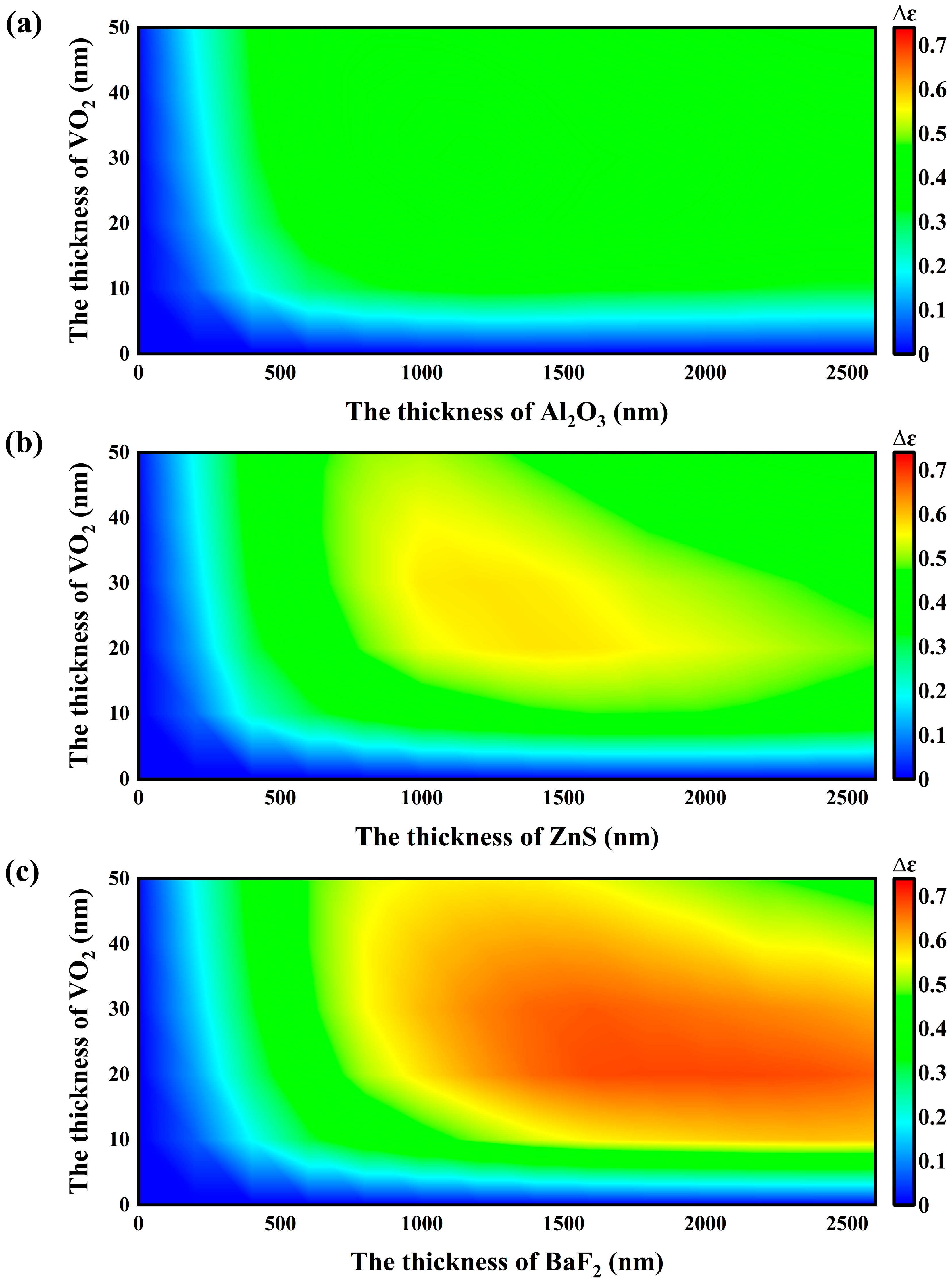
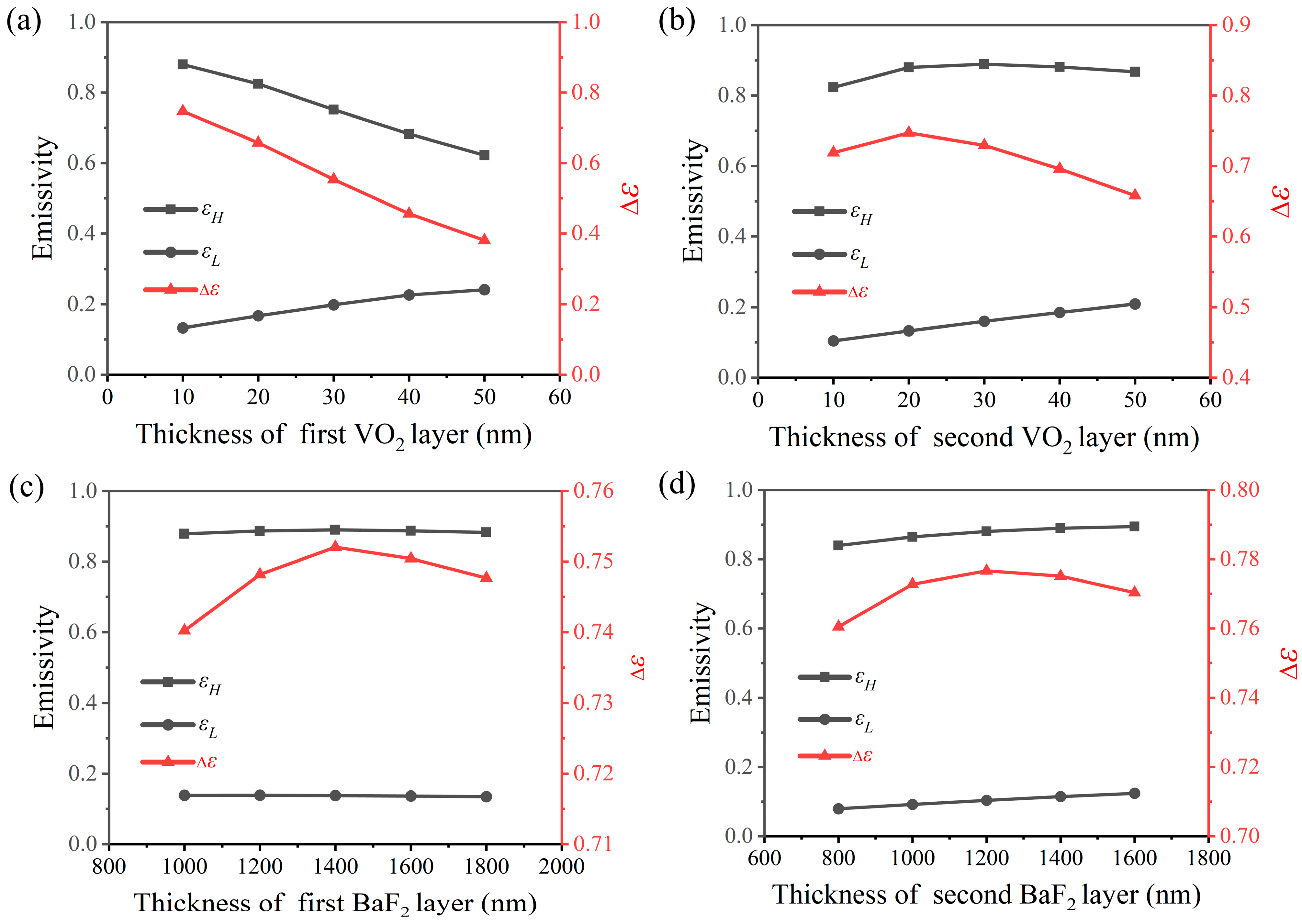

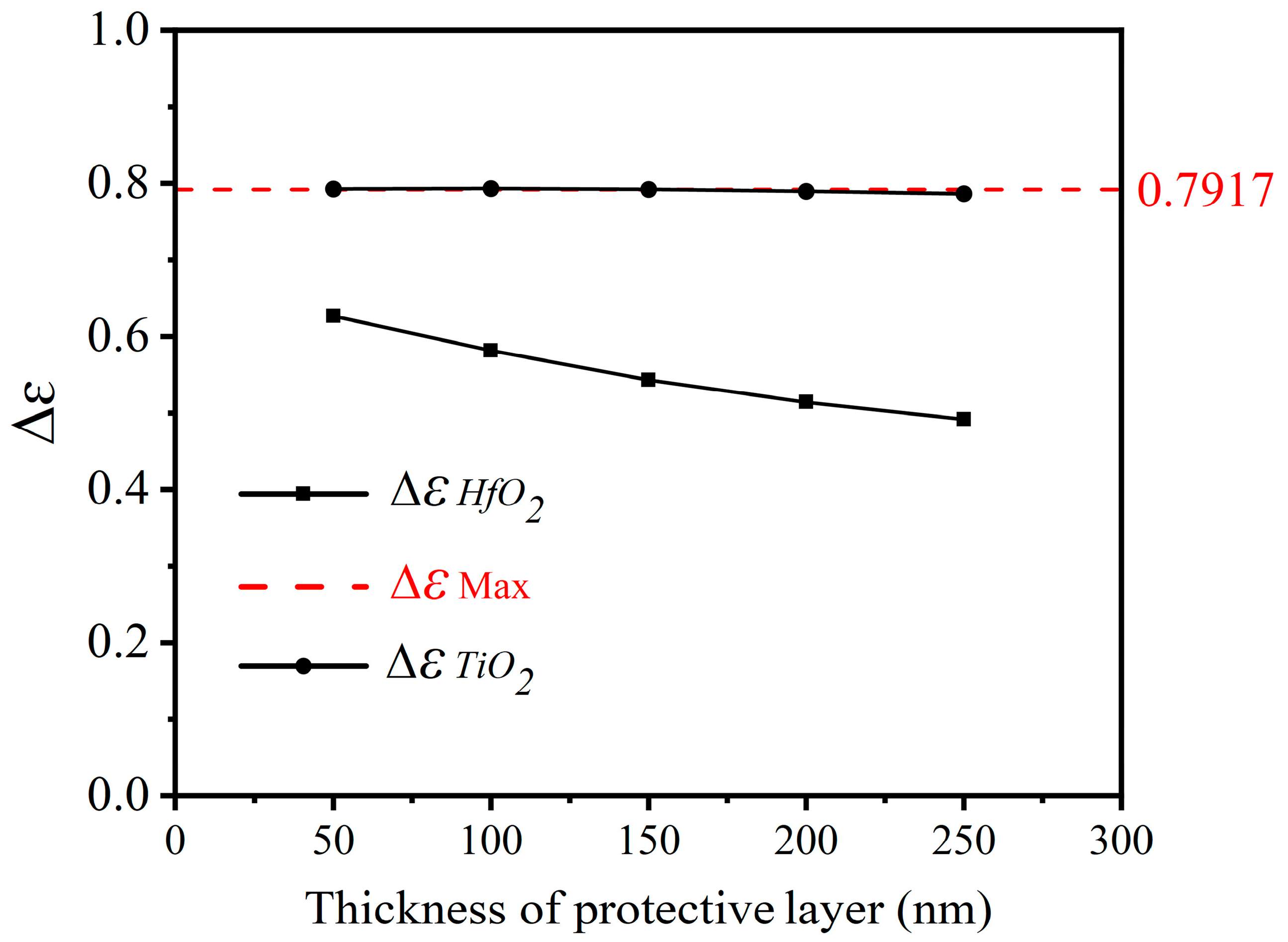
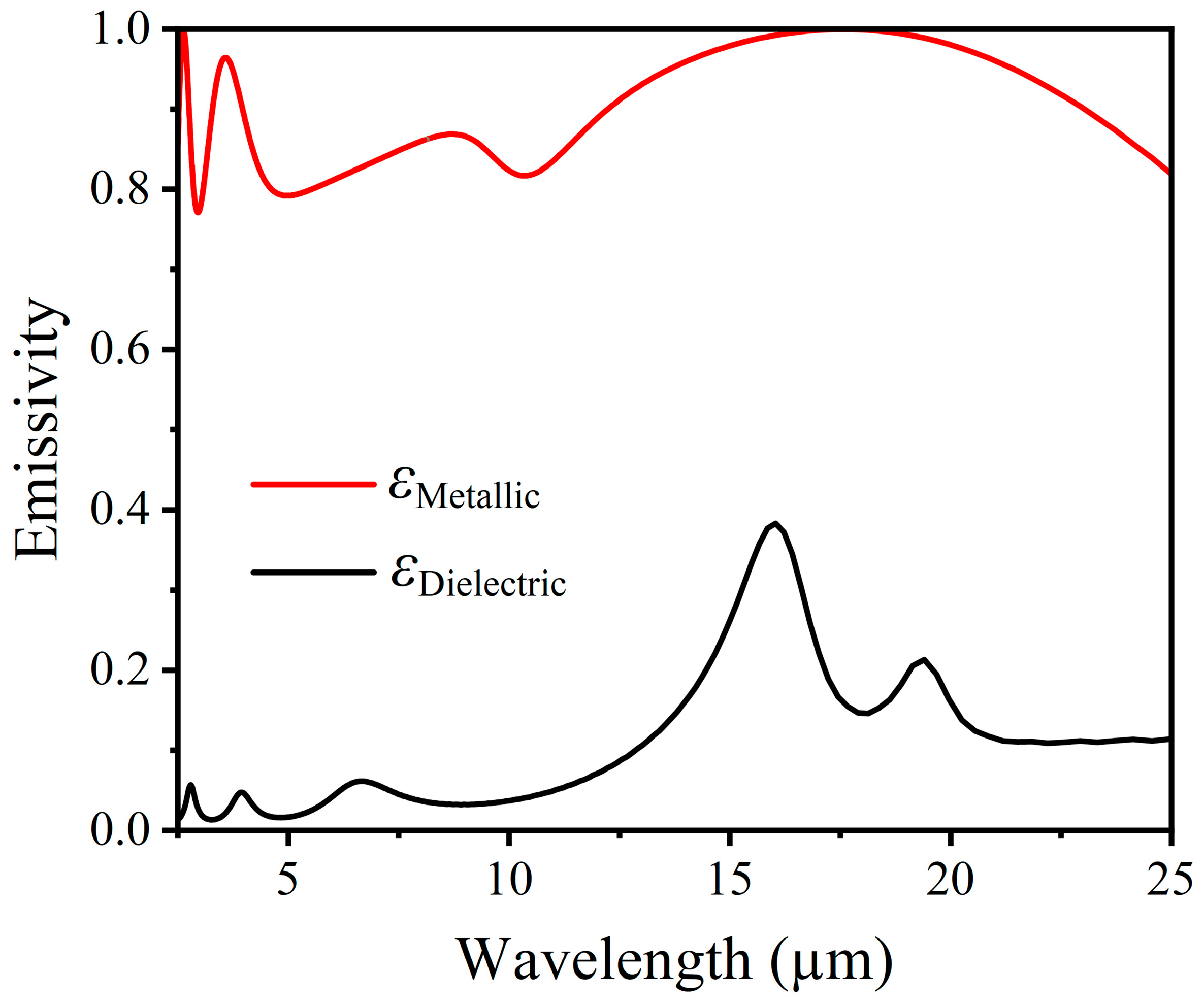
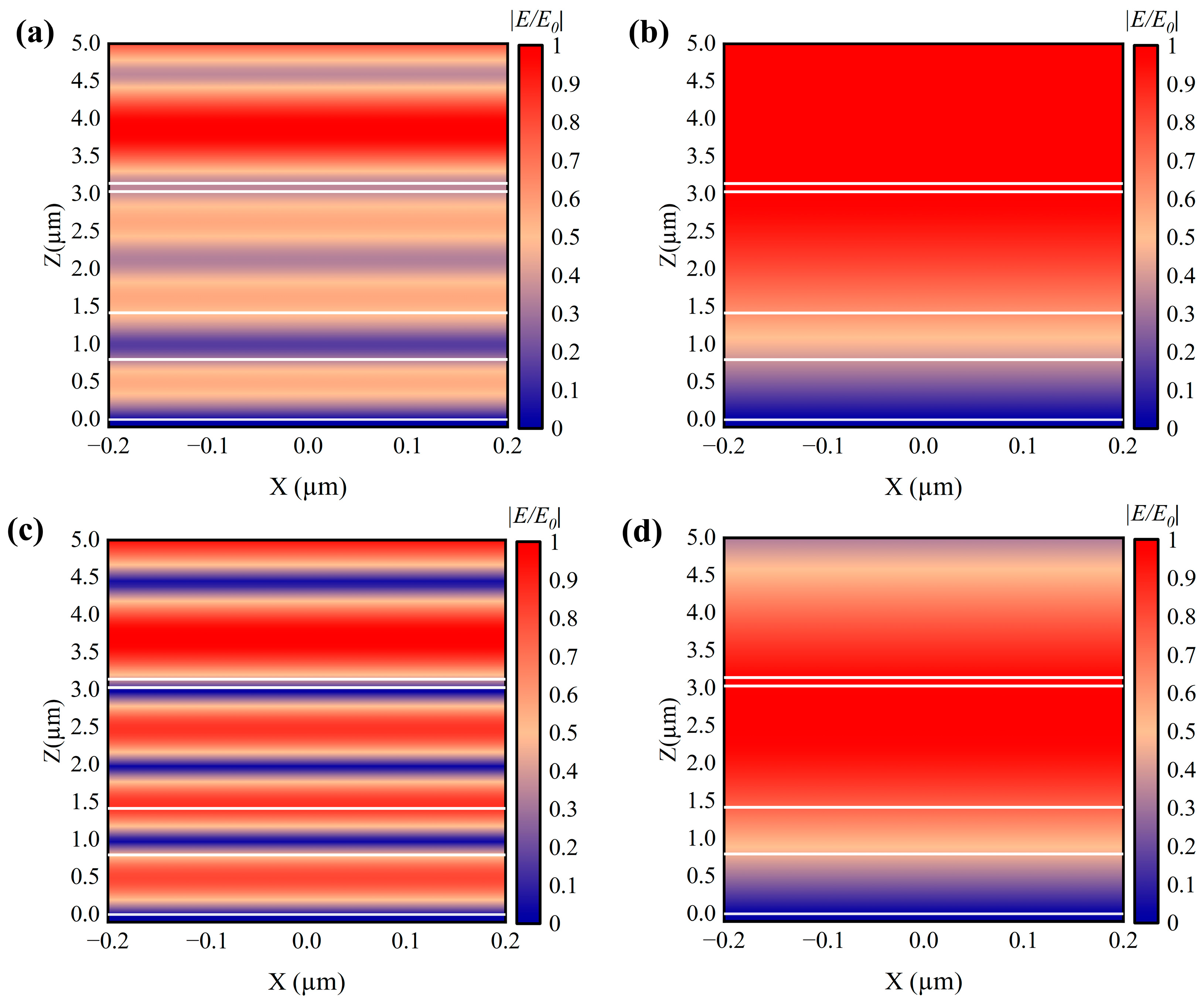
| Reference | Materials and Structure | εH | Δε |
|---|---|---|---|
| Hendaoui et al. [18] | VO2/HfO2/Ag | 0.68 | 0.55 |
| Wu et al. [22] | VO2/BaF2/Ag | 0.78 | 0.64 |
| Shrewsbury et al. [20] | VO2/ZnSe/VO2/ZnSe/Au | 0.77 | 0.69 |
| Zhang et al. [8] | Si/VO2/BaF2/Ag | 0.65 | 0.75 |
| This work | TiO2/VO2/BaF2/VO2/BaF2/VO2/Al | 0.90 | 0.79 |
Disclaimer/Publisher’s Note: The statements, opinions and data contained in all publications are solely those of the individual author(s) and contributor(s) and not of MDPI and/or the editor(s). MDPI and/or the editor(s) disclaim responsibility for any injury to people or property resulting from any ideas, methods, instructions or products referred to in the content. |
© 2024 by the authors. Licensee MDPI, Basel, Switzerland. This article is an open access article distributed under the terms and conditions of the Creative Commons Attribution (CC BY) license (https://creativecommons.org/licenses/by/4.0/).
Share and Cite
Xu, Q.; Ji, H.; Ren, Y.; Ou, Y.; Liu, B.; Wang, Y.; Chen, Y.; Long, P.; Deng, C.; Wang, J. VO2-Based Spacecraft Smart Radiator with High Emissivity Tunability and Protective Layer. Nanomaterials 2024, 14, 1348. https://doi.org/10.3390/nano14161348
Xu Q, Ji H, Ren Y, Ou Y, Liu B, Wang Y, Chen Y, Long P, Deng C, Wang J. VO2-Based Spacecraft Smart Radiator with High Emissivity Tunability and Protective Layer. Nanomaterials. 2024; 14(16):1348. https://doi.org/10.3390/nano14161348
Chicago/Turabian StyleXu, Qingjie, Haining Ji, Yang Ren, Yangyong Ou, Bin Liu, Yi Wang, Yongxing Chen, Peng Long, Cong Deng, and Jingting Wang. 2024. "VO2-Based Spacecraft Smart Radiator with High Emissivity Tunability and Protective Layer" Nanomaterials 14, no. 16: 1348. https://doi.org/10.3390/nano14161348





